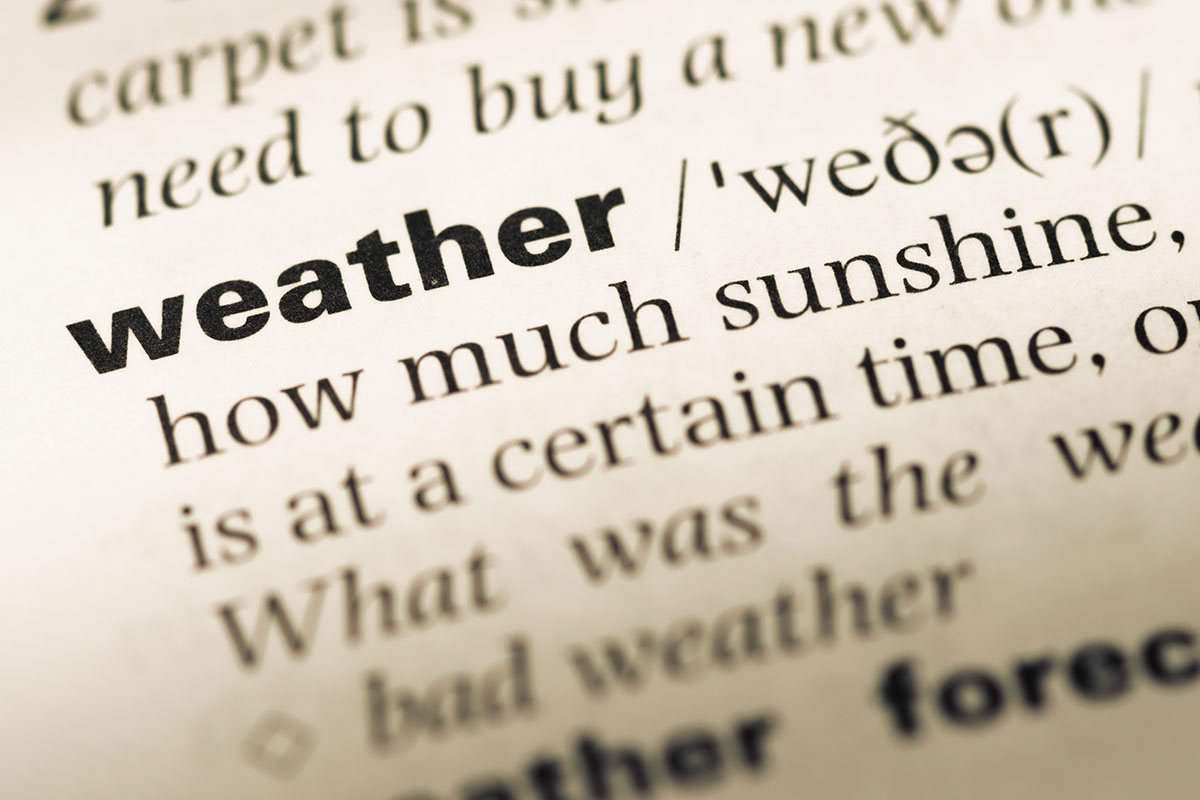With increasing emphasis on business intelligence (BI), analytics, and data science, there is also more interest than ever in weather, which has an enormous impact on business. But to effectively optimize weather data for your organization, it’s important to first gain a clear understanding of what weather terms mean in relation to BI.
There are more than 12,000 terms in the AMS Glossary of Meteorology and 2,000 terms in the National Weather Service Glossary. The field of meteorology is diverse and covers a range of disciplines, from micrometeorology to space weather, but none of these sources offer definitions through a BI lens.
Recognizing this need, Weather Source created the following glossary dedicated to the growing field of weather data for industry:
| Term | Definition |
| API | API stands for “Application Programming Interface.” This is a means in computer programming for one program to interact with another. At Weather Source, its most common use is with businesses or other entities that want to create an application to interact with our weather database. Using our API, subscribers gain full access to all OnPoint Weather data to create programs and applications specific to their organization. |
| API Key | A string of numbers and/or digits needed to access the Weather Source API. |
| Analytics-Grade | This refers to weather data that is of a certain quality and is well suited for immediate use in analytical and data science work. We have solved the challenges inherent in mining, combining, tailoring, and adapting crude weather data from various sources. |
| Anomaly | In weather data analytics involving climatology, an anomaly is a departure from normal. Weather Source provides past, present, and forecast weather and climate data that can be used to characterize anomalies. Weather anomalies tend to be the strongest drivers of unexpected business trends. |
| Artificial Intelligence (AI) | AI is a subset of data science focused on the development of algorithms and other technologies that simulate or augment human cognition and general intelligence. Weather Source employs AI to discover correlations between weather data and industry trends, behavior, and anomalies so meaning can be extracted and predictions can be made. |
| Business Intelligence (BI) | Modern BI platforms enable companies to harness big data and leverage it in a way that is visual, complete, and insightful. BI empowers organizations with the knowledge to make better business decisions faster. Weather for BI enables businesses to learn through analytics how weather affects their sales, energy, product distribution, organizational performance, and more. |
| CSV | CSV stands for “Comma Separated Values,” a common tabular data format used to transmit and/or deliver weather datasets. |
| Climatology | Climatology is the statistical representation of weather over time. OnPoint Climatology offers valuable information such as: the “normal” or “average” (mean) weather for any location at any point in time; departures from normal (standard deviations); and frequency of occurrence for specific weather parameters. This information is extremely useful for business planning. |
| DOY | In daily data, DOY stands for “Day of the Year” (0-366) in UTC (Coordinated Universal Time) at the point of interest. |
| DST Offset | In hourly data, the offset in minutes between Daylight Saving Time (DST) and Standard Time (ST) at the point of interest. |
| Daily Data | Weather data that is characterized by one weather observation per day, providing a summary of the weather for that corresponding day. |
| Data Platform | A data platform is an application relevant in the age of big data that manages datasets and is designed for analytics. Examples include Google Cloud Platform, Qlik, and Snowflake. Weather Source has relationships with several top-tier data platform providers. |
| Data Science | Data science encompasses the processes and technologies that enable the analysis and extraction of valuable insights from raw data. Weather Source is conducting extensive work in the field of data science and its AI and machine learning subsets to derive value from weather and climate data as it pertains to business. |
| Database | An organized collection of data generally stored and accessed electronically from a computer system. |
| Frequency of Occurrence | Frequency of occurrence insights reveal how often certain conditions occur at your location of interest; for example, how often it snows within the range of 1 to 2 inches or how many times it typically rains on a given day. |
| GeoJSON | GeoJSON is an open standard format designed for representing simple geographical features along with their non-spatial attributes. It is based on JSON, the “JavaScript Object Notation.” The features include points, line strings, polygons, and multi-part collections of these types. Weather Source uses the GeoJSON format to provide storm, hazard, and peril data via the OnPoint API. |
| Geospatial Data | Geospatial data identifies the geographic location of places, features, and/or boundaries on Earth. It is often combined with other data to provide an enhanced understanding in relation to regions or to the globe in general. At Weather Source, geospatial datasets are combined with weather and hazard data to provide everything from map-based visualizations to analytics. For example, combining census housing information with historical hail tracks can offer an understanding of areas that may be prone to hail-related roof damage. |
| Hourly Data | Weather data that is characterized by one weather observation per hour, providing a summary of the corresponding hour. |
| Hyper-Local | In weather data, hyper-local refers to the ability to tie weather values to a specific city block, business or residential address, the location of an automobile, or even an individual’s mobile phone. |
| ID | ID is an abbreviation for “identification.” All weather data has a geospatial component tied to it to indicate where on Earth the data is relevant. At Weather Source, all our weather data is geo-coded internally by an OnPoint ID, which is an integral part of our OnPoint Platform and is our proprietary reference number that identifies points of interest around the globe. |
| Insights | Insights are the meaningful, actionable patterns revealed through analytics that can be used in a predictive manner to forecast business performance. Insights are particularly relevant for BI. |
| JSON | In computing, JSON stands for “JavaScript Object Notation,” an open standard file format that uses human-readable text to transmit data objects. Our OnPoint API is JSON based. |
| Latitude | A geospatial coordinate value used in conjunction with longitude to provide a lat/lon coordinate pair in geospatial data to tie weather data to a location on Earth. |
| Longitude | A geospatial coordinate value used in conjunction with latitude to provide a lat/lon coordinate pair in geospatial data to tie weather data to a location on Earth. |
| Machine Learning (ML) | ML is a subset of data science in which computers adapt without the need for explicit programming, i.e., the machine may modify its own rule set to learn new rules for future problems. |
| Normal, Average, or Mean | Normal, average, or mean weather conditions refer to the statistical characterization of what is “normal” or what weather people generally expect for a given location at any given point in time. |
| Nowcast | Current weather data in the context of a forecast and synonymous with initialization conditions. |
| Observation | In weather, this refers to making a record of the current weather occurring at a location of interest. This can be achieved either through a visual observation with human eyes or a weather station designed to identify and communicate current weather. |
| Predictive Analytics | Predictive analytics are characterized by forecasted values for the future. Weather Source can create a full spectrum of analytical modeling that incorporates data science, AI/ML, forecasting, and simulations to offer predictive capabilities based on an array of specific attributes such as weather sensitivities, consumer response, and more. |
| Standard Deviation | In statistics, the standard deviation (SD, also represented by the lowercase Greek letter sigma “σ” for the population standard deviation or the Latin letter “s” for the sample standard deviation) is a measure used to quantify the amount of variation or dispersion of a set of data values. A low standard deviation indicates that the data points tend to be close to the mean of the set, while a high standard deviation indicates that the data points are spread out over a wider range of values. For example, at Weather Source we might look at standard deviations to characterize how extreme a weather anomaly actually is. |
| Tabular Data | A method of organizing data in a rectangular fashion, i.e. with rows and columns, for the purpose of presenting data or working with data tools and applications. Most Weather Source data is delivered in CSV format, which is easily imported into data tools and applications for use in operational settings. |
| Time Valid (LCL) | Actual time in local time (LCL) for which the weather is valid at the point of interest. The local time considers the offset from UTC and daylight savings time, if any, in effect by the local government at the point of interest. The result is the actual time everyone is/was/will be referring to at the point of interest at that time. OnPoint Weather automatically adjusts for time zone, daylight savings, and other anomalies such as leap years. |
| Time Valid (UTC) | UTC (Coordinated Universal Time) of the weather at the point of interest. UTC exists so weather observations around the world with various local times can be referenced with respect to a single, standard time. |
| Timestamp | A digital record of the time of occurrence of the weather record in the data. |
| Weather Model | A weather model is akin to a “digital twin,” or a best estimate of the state of the atmosphere. Models run through time to predict the future state of the atmosphere then generate a weather forecast. They can also be run back in time to depict past states of the weather. At Weather Source, we use weather models in conjunction with all of our past, present, and forecast data. |
Want to learn more about how the convergence of weather and data science can help your business intelligence strategy? Our products power the best and brightest organizations that take advantage of weather and climate data for business intelligence. Weather Source offers much more than a simple weather forecast—we aggregate and analyze data from the best weather sensors available to create “virtual” weather stations where it matters most to you.



